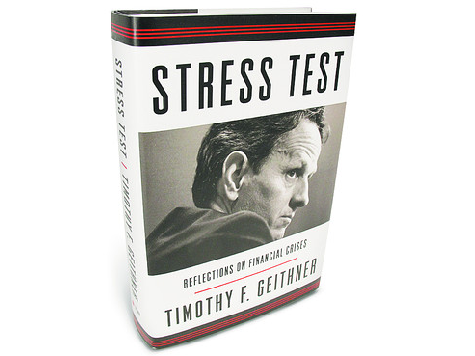
The most unique element of Timothy Geithner’s new 580 page book Stress Test is that he seems to have actually written it. As former President of the New York Federal Reserve Bank from 2003 to 2009 and then U.S. Treasury Secretary during the financial crisis, Geithner tells the story of what it was like to be faceless senior-level bureaucrat who is thrust onto the world scene and agrees to “foam the runways” to prevent the New York financial institutions he regulated from suffering “Old Testament” punishment for their greed and avarice.
Geithner describes his formative years as “I had an extraordinary childhood, but I was an ordinary kid.” He grew up as the son of the Ford Foundation executive who ran programs in Southeast Asia. Geithner, who speaks a number of languages including Chinese and Thai, got a job as a consultant on Southeast Asia with Henry Kissinger’s firm after college. He would later serve in the U.S. Treasury and International Monetary Fund (IMF) as a senior executive. He credits this empathy with impoverished people “who live on $2 a day” for inspiring him in 1999 to propose the “Year of Jubilee” to “substantially reduce the loans of the IMF and World Bank to the poorest countries and to write off the U.S. government loans entirely over time.”
In the first third of the book, Geithner constantly refers to his mentor, “Larry.” Geithner met Larry Summers while working as a mid-level executive in the Treasury Department in 1992, when Summers was coming in as the U.S. Treasury Secretary in the Clinton Administration. Geithner says that “Larry opened my eyes to the possibilities of economics as a lens for thinking about the world and a tool for improving people’s lives.”
Geithner seems in awe of “Larry” after the Treasury Secretary said he “could envision me as the managing partner of a law firm, or running some big institution, if only my credentials weren’t so thin.” A year later, Larry would appoint Geithner to the powerful position of Deputy Assistant Secretary of Treasury, a job for which Geithner had almost no credentials to apply. “Larry” assigned Geithner to work with the G-7 and IMF for the “legitimate objective” to fight for the New York banks’ interest in breaking down “Japan’s trade barriers in financial services.”
Over the eight years of the Clinton Administration, Geithner would participate in a series of financial crisis restructurings that included Mexico, Thailand, Brazil, Long Term Capital Management, and others. The work-outs were led by Robert Rubin as former Goldman Sachs CEO and head of President Clinton’s National Economic Council; Treasury Secretary “Larry” Summers; and Federal Reserve Chairman Alan Greenspan. In 1999 “Time magazine featured Rubin, Summers, and Greenspan on their cover as ‘The Committee to Save the World.'”
In each of these financial crises Geithner rejected complaints by “some of our partners in Europe – and some conservative critics at home” who believed that bailing out borrowers and banks created a “moral hazard,” because other borrowers and banks would take higher risks assuming that they too would get bailed out. Geithner discards these concerns because “condoms don’t cause sex” and “the existence of firehouses doesn’t cause fires.”
Geithner left Treasury when Clinton left office to work for the IMF. But in 2003, with no PhD or background in retail or commercial banking, Geithner was secretly recruited by his mentors “Larry” Summers as President of Harvard University, and Robert Rubin as Director and Senior Advisor to Citicorp bank, to be President of the New York Federal Reserve. At the unheard-of age of 42, Geithner would be in charge of all New York money center banks, all New England banks, all Federal Reserve issuing and trading of securities, all derivative contract rules and trading, and serve as Vice Chairman of the committee that sets monetary policy and interest rates.
Perhaps the most stunning aspect of the first third of “Stress Test” is that Geithner does not seem to have any empathy for the negative impacts his bailouts and debt buildup may have on the average U.S. citizen. It is very clear in Stress Test that Geithner still resents the American public’s concerns:
Still plenty of Americans who don’t believe in unicorns do believe we bungled the crisis. The public despised our financial rescues, to the extent that the President joked, that Washington dinner in mid-2009 that he needed to house train his dog, Bo, ‘because the last thing Tim Geithner needs is someone else treating him like a fire hydrant.’
In Part II of this series, I will lay out how the two American towns that benefited the most from Geithner’s bailouts are New York and Washington DC, the two risk takers that would have suffered Old Testament punishment for their greed and avarice.
***
The author welcomes feedback and will respond to comments by readers.

COMMENTS
Please let us know if you're having issues with commenting.